10 Most Popular Cheeses Originated in Switzerland

Welcome to a world of rich flavors, creamy textures, and culinary heritage that stretches back centuries. Today, we embark on a mouthwatering journey through the breathtaking landscapes of Switzerland to discover its crowning glory – cheese!
This small yet diverse country is renowned for its cheese-making prowess, producing over 450 different types. But among this wide assortment, there are ten that stand out for their unique flavors, intriguing histories, and universal popularity.
From the famous Emmentaler and Gruyère to the lesser-known but equally delightful Schabziger and L’Etivaz, these Swiss cheeses have won the hearts of gourmets worldwide. So, join us as we explore the 10 most popular cheeses that originated in Switzerland, each with its own story to tell and flavor to savor.
The 10 Most Popular Swiss Cheeses (BEST)
| Cheese | Description | Tasting Profile |
|---|---|---|
| Emmentaler | A yellow, medium-hard cheese that originated in Emmen, Switzerland. Recognized by its distinctive holes. | Smooth, semihard, with a firm, dense body, and unique flavor. |
| Gruyère | A hard cheese known for its slightly sweet and salty flavor. Versatile in use. | Sweet and salty, with a creamy and nutty taste. |
| Sbrinz | An extra-hard Swiss cheese often used as a grating cheese. | Spicy, full-bodied flavor. |
| Tête de Moine | Translated as “Monk’s Head,” this cheese is traditionally scraped into thin rosettes. | Distinct, tangy flavor. |
| Appenzeller | Encased in a unique herbal brine, known for its spicy and fruity flavor. | Spicy and fruity, with a mild herbal undertone. |
| Vacherin Fribourgeois | A creamy and nutty cheese that melts well, perfect for fondues. | Creamy, with a rich, nutty taste. |
| L’Etivaz | Created through traditional methods in alpine dairies. | Fruity, slightly tangy flavor. |
| Swiss Tilsit | A semi-hard cheese known for its pungent aroma. | Slightly sour taste. |
| Vacherin Mont d’Or | A soft, rich cheese that’s typically eaten with a spoon directly from its box. | Creamy, with a distinct rich flavor. |
| Schabziger | A hard, cone-shaped cheese made from skimmed cow’s milk and flavored with blue fenugreek. | Unique taste due to the blue fenugreek flavor. |
1. Emmentaler
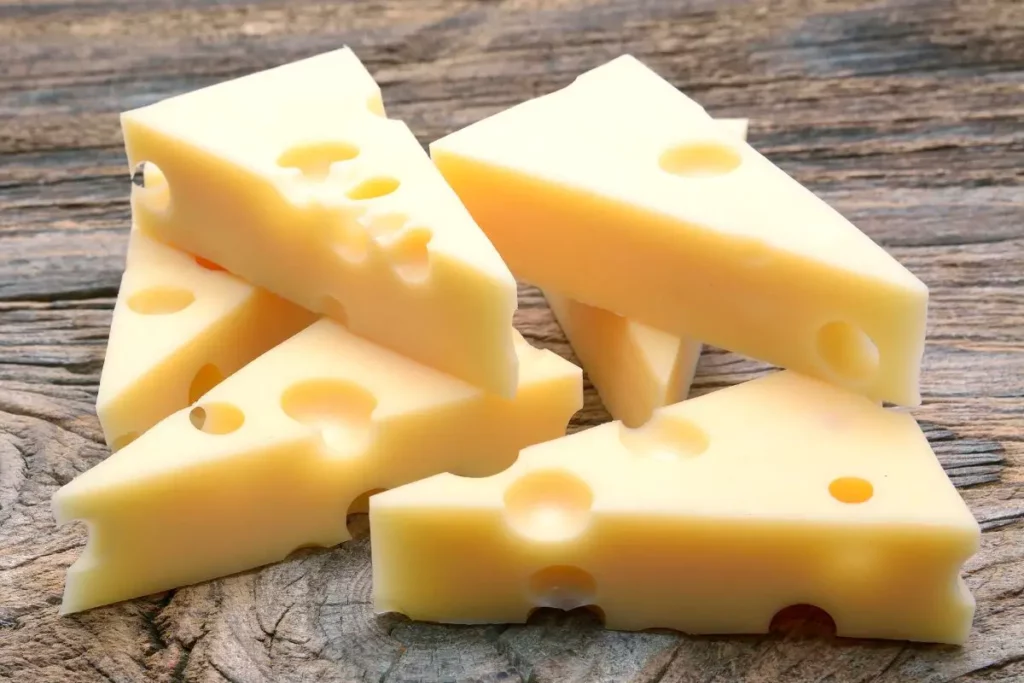
- Milk Type: Cow’s milk
- Taste: Mild, slightly nutty and fruity
- Texture: Hard, with distinctive large holes
- Food Pairing: Classic in sandwiches, on top of soups, and in fondue
- Wine Pairing: Pairs well with a Chardonnay or light-bodied red wine
- Read in-depth guide
Emmentaler is renowned worldwide and holds a special place in the Swiss cheese tradition. It is a hard, cow’s milk cheese known for its large holes or ‘eyes’, and a buttery, slightly nutty flavor. Emmentaler’s texture is smooth yet firm, making it an excellent choice for slicing and melting. Its taste can range from mildly fruity to sharp, depending on its age.
Whether it’s used to top off a classic Swiss fondue, melted in a sandwich, or savored on its own with a glass of wine, Emmentaler adds a versatile and delightful element to the culinary experience.
2. Gruyère

- Milk Type: Cow’s milk
- Taste: Slightly sweet and salty
- Texture: Hard, dense, and smooth
- Food Pairing: Great in gratins, fondues, and quiches
- Wine Pairing: Pairs well with a Sauvignon Blanc or medium-bodied red wine
- Read in-depth guide
Gruyère is a classic Swiss cheese known for its sophisticated flavor and versatility in the kitchen. This hard cheese, made from cow’s milk, is often recognized by its dark, firm rind and smooth, creamy interior that’s dotted with small holes. Gruyère offers a complex flavor profile – it starts off sweet and nutty, gradually intensifying to a more earthy and savory taste as it ages.
Its excellent melting properties make it a preferred choice for dishes like fondue, gratins, and quiches. Whether savored on its own, paired with a robust red wine, or used in cooking, Gruyère brings a touch of Swiss elegance to any culinary experience.
3. Sbrinz
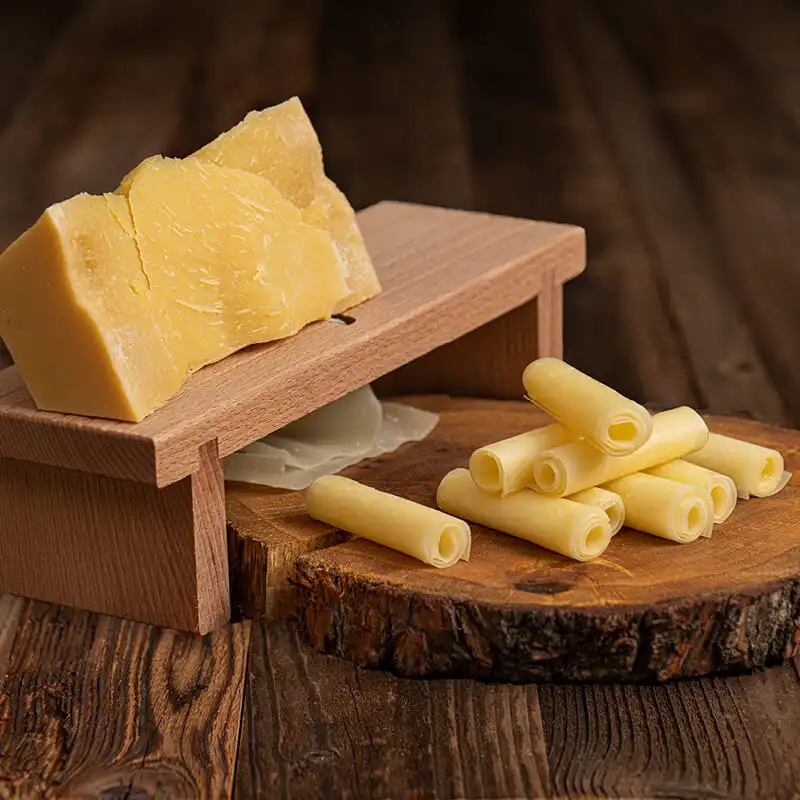
- Milk Type: Cow’s milk
- Taste: Spicy and full-bodied
- Texture: Extra-hard, often used as a grating cheese
- Food Pairing: Perfect for pasta dishes and risottos
- Wine Pairing: Pairs well with robust red wines like Merlot
Sbrinz is a hard, premium Swiss cheese known for its rich and full-bodied flavor. Made from cow’s milk, Sbrinz has a deep-rooted history in Switzerland, being one of the oldest cheeses in Europe. The cheese is often mistaken for Parmesan due to its grainy texture and propensity for being grated, but it holds a unique taste all its own.
It boasts a strong, spicy flavor when matured, and a milder, milky taste when young. Perfect for grating over pasta or risotto, and equally delightful when served in chunks with aperitifs, Sbrinz adds a robust and sophisticated touch to a variety of culinary delights.
4. Tête de Moine
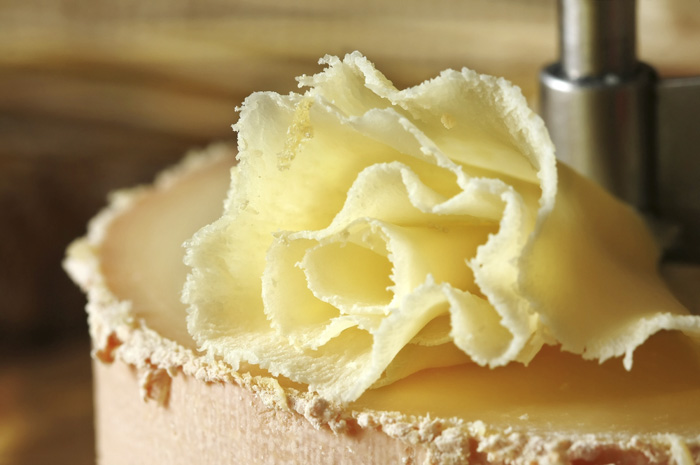
- Milk Type: Cow’s milk
- Taste: Distinct, tangy flavor
- Texture: Semi-hard, traditionally scraped into thin rosettes
- Food Pairing: Excellent with fruits and on charcuterie boards
- Wine Pairing: Pairs well with sparkling wines or a light, fruity red wine
Tête de Moine is a semi-hard cheese, made from cow’s milk, and originates from the Jura region of Switzerland. The name ‘Tête de Moine’, which translates to ‘Monk’s Head’, hints at its historic roots in the monastic traditions. The cheese is known for its intense, full-bodied flavor that is slightly tangy with a melt-in-the-mouth consistency. Tête de Moine is traditionally served in an unusual way – it’s shaved into thin, rosette-like curls using a special tool called a ‘girolle’.
This not only makes for an attractive presentation but also enhances the cheese’s flavor by allowing more surface area to be exposed to air. Whether it’s the centerpiece of a cheese platter or an elegant garnish, Tête de Moine adds a touch of Swiss charm to any occasion.
5. Appenzeller

- Milk Type: Cow’s milk
- Taste: Spicy and fruity, with a mild herbal undertone
- Texture: Hard, with a unique herbal brine rind
- Food Pairing: Delicious on bread or melted in fondue
- Wine Pairing: Pairs well with full-bodied white wines or light red wines
- Read in-depth guide
Appenzeller is a traditional cheese that hails from the Appenzell region of Switzerland. This hard cheese is made from thermized cow’s milk, sourced from cows grazing on the lush Alpine meadows of the region. Appenzeller cheese is unique due to its secret herbal brine wash, which contributes to its distinctive flavor profile.
The cheese offers a perfect balance between mild and aromatic tastes, making it a true delight for cheese lovers. It’s a full-fat, semi-hard cheese that is carefully selected and matured to ensure the highest of standards. Whether enjoyed on its own or incorporated into a dish, Appenzeller brings a touch of Swiss authenticity to every bite.
6. Vacherin Fribourgeois
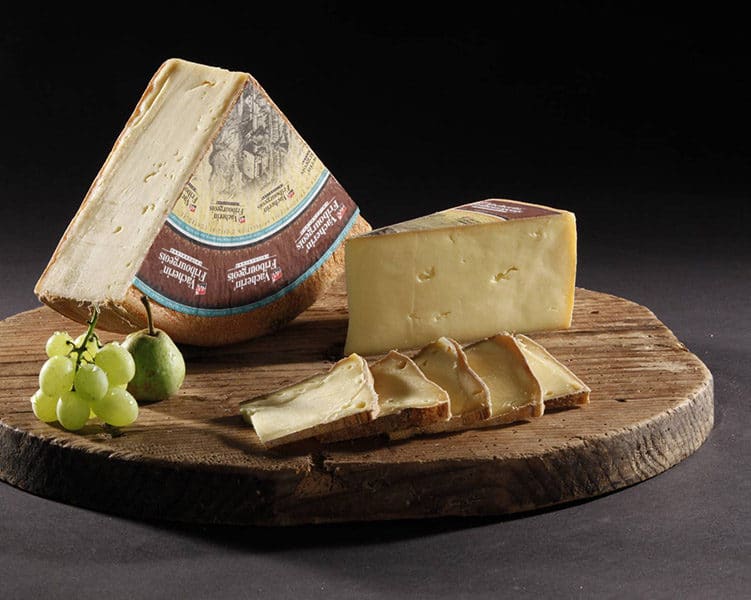
- Milk Type: Cow’s milk
- Taste: Creamy and nutty
- Texture: Semi-hard to hard, melts well
- Food Pairing: Excellent in fondue and raclette
- Wine Pairing: Pairs well with a full-bodied white wine or a light red wine
- Read in-depth guide
Vacherin Fribourgeois is a renowned cheese originating from the canton of Fribourg. Made from raw cow’s milk, this cheese is celebrated for its rich, creamy texture and slightly grainy mouthfeel. The flavor profile of Vacherin Fribourgeois is complex yet harmonious, offering a blend of nutty, earthy notes when young that mature into a more robust and aromatic taste as it ages.
Its excellent melting qualities make it a popular choice for traditional Swiss dishes such as fondue and raclette. Whether enjoyed on a cheeseboard or in culinary creations, Vacherin Fribourgeois brings a touch of Swiss tradition and gusto to every occasion.
7. L’Etivaz
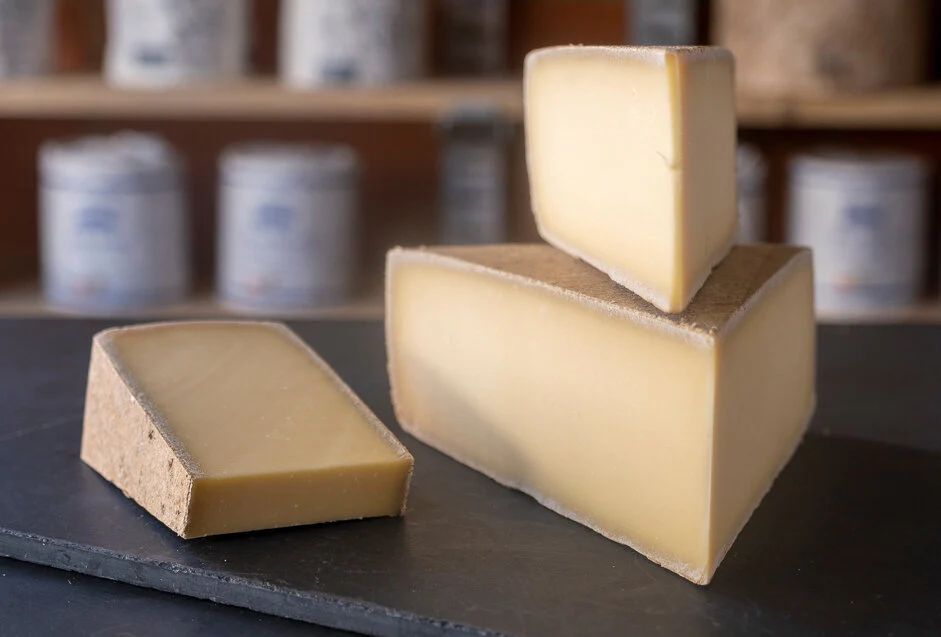
- Milk Type: Cow’s milk
- Taste: Fruity, slightly tangy flavor
- Texture: Hard, with a slightly crumbly texture
- Food Pairing: Perfect for grating over dishes or on a cheese plate
- Wine Pairing: Pairs well with a dry white wine or a fruity red wine
L’Etivaz is a treasured Swiss cheese known for its robust and unique flavor profile. This hard cheese is crafted from raw cow’s milk in the alpine creameries of the Vaud Alps, with its production adhering to traditional methods. The cheese is recognized for its distinct fruitiness, balanced by notes of roasted hazelnuts and savory undertones.
L’Etivaz is produced seasonally, between May and October, when the cows graze on the rich, natural meadows of the Alps. This grazing contributes to the cheese’s full-bodied aroma of alpine herbs. Whether savored on its own or incorporated into a culinary masterpiece, L’Etivaz brings a piece of Swiss heritage to the table.
8. Swiss Tilsit

- Milk Type: Cow’s milk
- Taste: Slightly sour
- Texture: Semi-hard, with small holes
- Food Pairing: Great in sandwiches or melted on top of dishes
- Wine Pairing: Pairs well with a medium-bodied white wine or a light red wine
Swiss Tilsit is a semi-hard, smear-ripened cheese that exudes a pale yellow hue. This cheese, originally crafted by Prussian-Swiss settlers in the mid-19th century, is celebrated for its creamy texture and intriguing flavor profile. It bears a resemblance to Havarti but offers a fuller and more intense taste. With a brownish-orange washed rind and made of partially skimmed cow’s milk, Swiss Tilsit is a flavorful delight.
Its fat content sits at around 45%, making it a relatively light choice for cheese lovers. Whether used in home cheese making or enjoyed as is, Swiss Tilsit offers a unique taste experience, ranging from mild and buttery when young to hints of cheddar as it ages.
9. Vacherin Mont d’Or
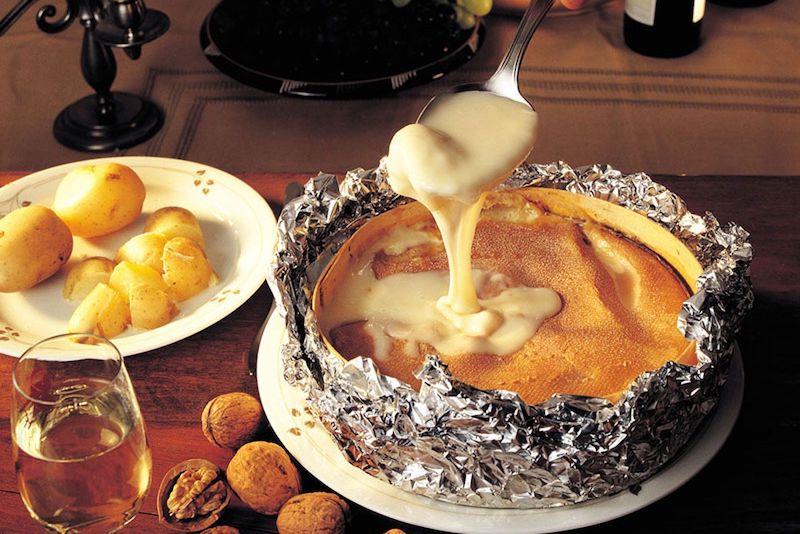
- Milk Type: Cow’s milk
- Taste: Rich and creamy
- Texture: Soft, often eaten with a spoon
- Food Pairing: Delicious on its own, on bread, or with potatoes
- Wine Pairing: Pairs well with a sweet white wine or a fruity red wine
- Read in-depth guide
Vacherin Mont d’Or is a highly esteemed Swiss cheese, cherished for its creamy, melt-in-your-mouth texture and complex flavor. Produced in the Jura region of Switzerland, this cheese is crafted from raw cow’s milk only during the winter months, making it a seasonal delicacy. The cheese is encased in a spruce bark wrap, which imparts a unique woody note to its flavor profile.
Vacherin Mont d’Or boasts a delicate balance of tastes, featuring fruity undertones and a slightly resinous edge. It is often enjoyed warm, scooped directly from its wooden box, providing a sumptuous, fondue-like experience that truly sets it apart from other cheeses.
10. Schabziger
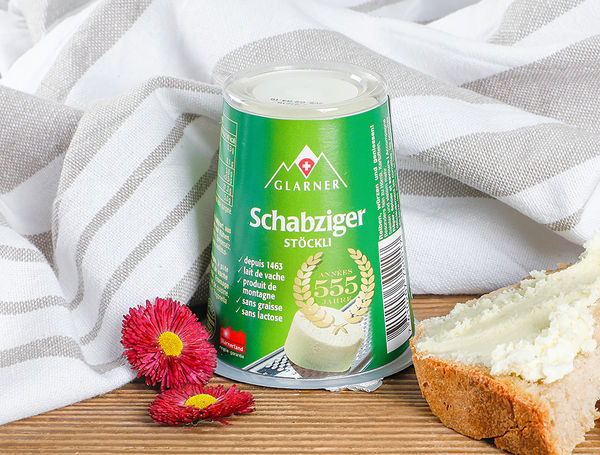
- Milk Type: Skimmed cow’s milk
- Taste: Unique taste due to the blue fenugreek flavor
- Texture: Hard and crumbly
- Food Pairing: Traditionally mixed with butter to spread on bread
- Wine Pairing: Pairs well with a dry white wine or a light red wine
Schabziger, also known as Sap Sago or Swiss Green Cheese, is a traditional Swiss cheese exclusively produced in the Canton of Glarus. This hard cheese, dating as far back as the 8th century, is made from skimmed cow’s milk and has a distinctive green color thanks to an herbal mix of blue fenugreek.
Schabziger is unique in its almost fat-free nature and comes packaged in a 3.17-ounce cone. It’s known for its spicy and robust flavor, making it a versatile ingredient in dishes like Schabziger Spaghetti. As the oldest brand product in the world, Schabziger continues to be a symbol of Swiss culinary heritage.
Final Thoughts
And there you have it – a delectable journey through the verdant valleys and snow-capped peaks of Switzerland told through the rich, varied stories of its most iconic cheeses. Whether you’re a cheese connoisseur or a curious foodie, we hope this exploration has inspired you to delve deeper into the world of Swiss cheeses.
Remember, each of these cheeses offers more than just a unique flavor – they offer a taste of Switzerland itself. So, the next time you find yourself in front of a cheese board, don’t just slice, savor the story behind every morsel!
Also read:
- 10 Most Popular Cheeses Originated in Slovenia
- 8 Most Popular Cheeses Originated in Romania
- 10 Most Popular Cheeses Originated in Norway
- 10 Most Popular Cheeses Originated in the Middle East
- Top 5 Most Popular Cheeses in Lithuania
- 10 Most Popular Cheeses Originated in Italy
- 9 Most Popular Cheeses Originated in India





